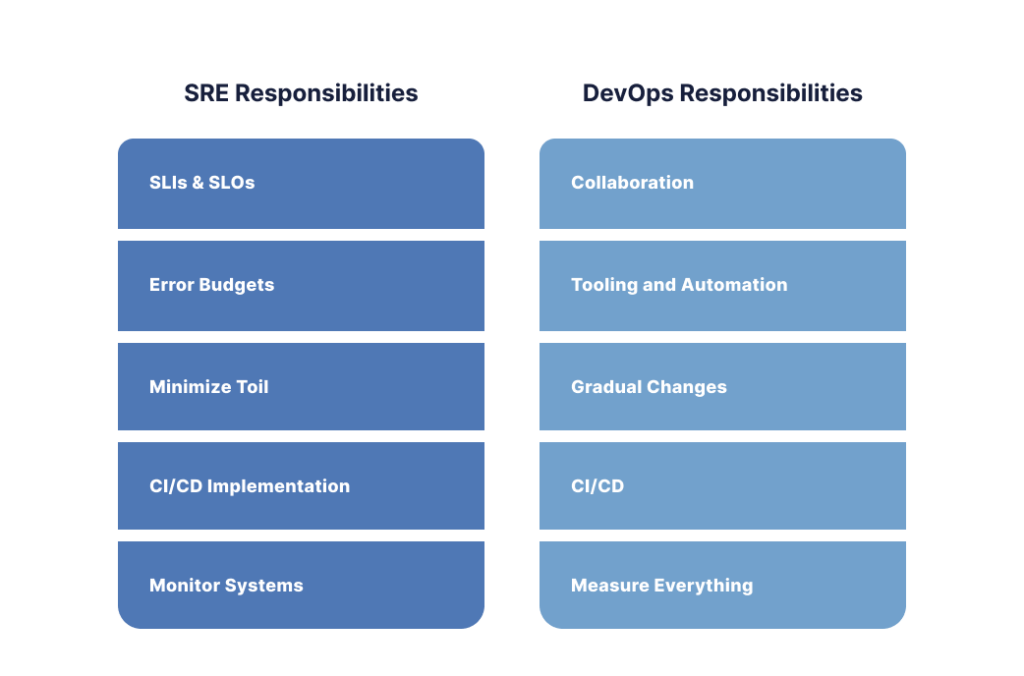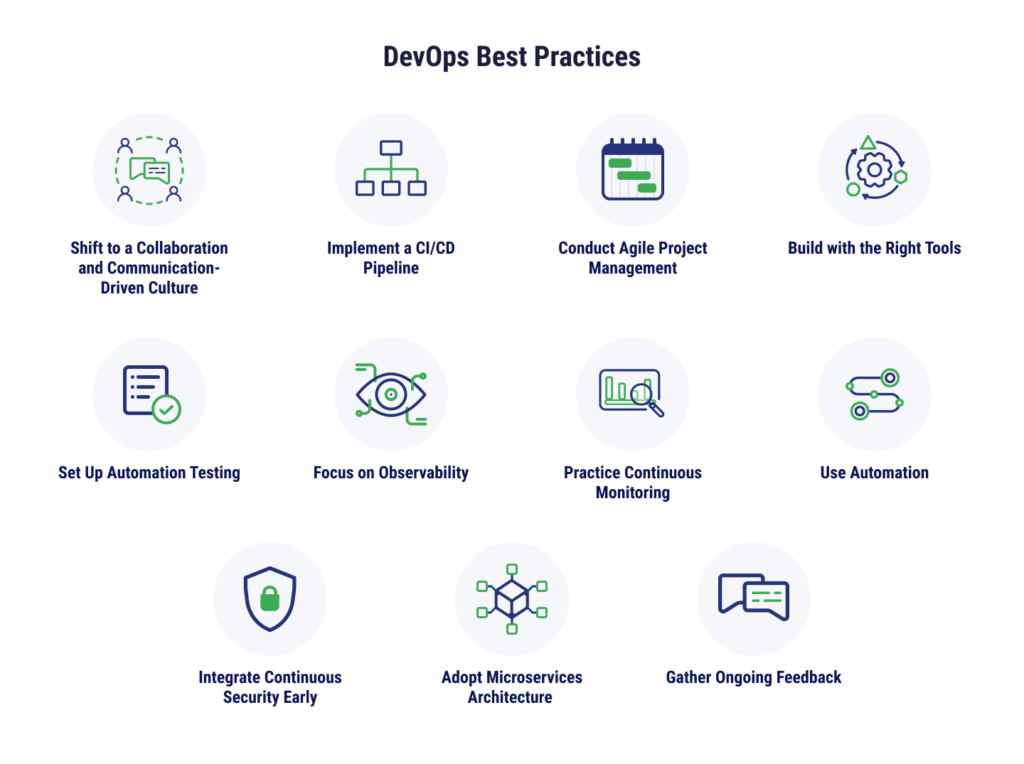
As companies look to the future, it’s necessary to find new and exciting ways to stay attractive to potential and current customers. It’s also crucial to remain swift and timely when it comes to product improvements. If new applications get bogged down in development, or bugs aren’t fixed fast enough, customers can slip through the cracks.
Businesses looking to speed up their time to market, innovate more effectively, and improve application quality can do so by adopting a DevOps model. This model brings development and operations teams together to achieve a common goal: Efficient collaboration throughout the development and testing of applications.
Here are the 11 best practices organizations should keep in mind when implementing a DevOps transformation.
What is DevOps?
DevOps is a process approach designed to speed up application changes and reduce errors by combining software development processes (Dev) and software operations (Ops). Efficiencies come from automation and monitoring being brought together throughout the application development process. The best DevOps team can deploy faster and instill more faith in end users. Plus, with the operations team involved, end business objectives are considered along with testing.
Some businesses may choose to have a DevOps team and a site reliability engineer (SRE) team. An SRE team is responsible for operational functions – monitoring systems, implementing the CI/CD pipeline, and designing systems for the DevOps team to use. In contrast, DevOps teams are focused on removing barriers between the development and operations teams with the end goal of creating solutions that achieve organizational goals.

Why is DevOps Important?
DevOps plays an important role in fostering collaboration by breaking down barriers between the development and operations teams. When set up properly, a DevOps team can accomplish more in a shorter time frame than two distinct teams implementing a more divided chain of command. By engaging in this cultural shift, businesses can see improvements in agility, teamwork, data quality, and business value.
What Are the Three P’s of DevOps?
You may hear people talk about the three P’s when they refer to DevOps, which are the people, processes, and tools that enable efficiency in the pipeline. When you get your people, processes, and pipeline aligned, the development and improvement process can run like a well-oiled machine.
Our Top 11 DevOps Best Practices for Implementation
Building a strong DevOps practice at your business requires culture change, automation, and a significant investment in technology. Implementing these 11 best practices can move your teams from siloed to in sync.

1. Shift to a Collaboration and Communication-Driven Culture
A DevOps migration strategy is just as much about setting new cultural team expectations as it is about making sure the technology and tools are right for the job. Encouraging regular meetings, setting up knowledge-sharing sessions, and creating shared goals can help shift a separated environment to one that thrives on collaboration and communication. Create shared communication channels, pair members of each team together to learn from one another, and have regular stand-up meetings to start making connections and moving toward work as a unit.
2. Implement a Continuous Integration/Continuous Deployment (CI/CD) Pipeline
A continuous integration/continuous deployment (CI/CD) pipeline involves regularly making updates to a software application with the goal of iterative improvement.
By adopting a CI/CD approach, teams can reduce the risk of introducing bugs or errors into the codebase, as small changes are tested and deployed incrementally. This iterative approach to development promotes faster feedback loops, enabling teams to respond promptly to customer feedback and market demands.
Moreover, CI/CD pipelines enhance collaboration and transparency within development teams, as everyone has visibility into the status of code changes and deployments. This fosters a culture of continuous improvement and innovation, driving the delivery of high-quality software that meets the evolving needs of customers.
3. Conduct Agile Project Management
Up the productivity of your DevOps team by implementing agile project management frameworks or technologies, such as Scrum or Kanban. Use boards to visualize what needs to be done, what’s currently in progress, and what’s getting in the way of finishing parts of projects.
4. Build with the Right Tools
The more you can use tools, like artifical intelligence or machine learning, that integrate easily with your existing systems, the more likely it is that the DevOps team will embrace them. Not only can these tools improve the project management process, but they can also package applications, automate regular tasks, check for errors, and streamline workflows.
5. Set Up Automation Testing
In today’s competitive landscape, companies recognize the need for swift and timely product improvements to maintain customer satisfaction and loyalty. Automation testing plays a crucial role in this process by allowing organizations to identify and fix bugs quickly, ensuring that new applications are developed efficiently and delivered to market faster. By automating repetitive testing tasks, companies can increase testing coverage, improve accuracy, and accelerate the release cycle, ultimately enhancing the overall quality of their products and services.
6. Focus on Observability
Especially in the early days of a new DevOps team, visibility is key. By visualizing system metrics through effective monitoring, logging, and tracing practices, the team gains invaluable insights into the performance and health of their applications and infrastructure. This visibility not only enables swift detection and resolution of issues but also fosters a culture of continuous improvement, as the team collaboratively works towards shared goals, ensuring optimal performance and reliability of their system.
7. Practice Continuous Monitoring
Observability and monitoring work well together. Observability can help illuminate the relationship between data points, while monitoring can alert teams to key data points that may require additional action. Use tools to set up alerts for critical events, and constantly monitor your environment for potential performance and security issues. Through continuous monitoring, DevOps teams can proactively address problems before they become an impediment for users.
8. Use Automation
Infrastructure provisioning, deployments, and configuration management can all be automated to reduce friction in your team’s processes.
By automating the provisioning, configuration, and management of infrastructure resources, teams can achieve greater efficiency, consistency, and scalability in their operations. Infrastructure as Code (IaC) tools like Terraform, enable teams to define infrastructure components programmatically, treating infrastructure configurations as code that can be version-controlled, tested, and deployed alongside application code.
Automating infrastructure empowers teams to rapidly adapt to changing requirements, provision resources on-demand, and maintain infrastructure consistency across development, testing, and production environments, ultimately accelerating the delivery of reliable and resilient software solutions.
9. Integrate Continuous Security Early
The earlier security vulnerabilities are caught, the less likely they are to impact your end users. By implementing continuous security scanning and vulnerability assessments from the outset of development, teams can proactively identify and address security vulnerabilities before they pose a risk to end users. Waiting until after deployment to address security concerns can lead to costly and potentially damaging security breaches. By incorporating security checks into the CI/CD pipeline, teams can automate security testing and ensure that security measures are applied consistently throughout the development lifecycle. This not only enhances the overall security posture of the application but also fosters a culture of security awareness and responsibility among team members.
10. Adopt Microservices Architecture
Breaking down applications into smaller pieces can make them easier to manage from a development and deployment perspective. A microservices architecture can also scale more efficiently and boost your agility. Containers and API gateways can be used between microservices for communication and management.
11. Gather Ongoing Feedback
Cultural shifts are never going to be seamless, but taking feedback along the way and adjusting when necessary can make DevOps team members feel heard and allow you to handle emerging issues quickly. Use feedback to improve your tools, applications, and processes, and take input from stakeholders at all levels and steps in the development cycle.
Enhance DevOps Best Practices With TierPoint
If you’re looking to innovate using your existing Microsoft Azure or AWS cloud infrastructure and optimize IT, a DevOps approach can help you:
- Speed up time to market
- Reduce risk
- Improve collaboration
- Experience better consistency
Ready to learn more about how this approach can benefit your business? At TierPoint, we’re happy to help. We offer DevOps consulting services that can help you build, plan, implement, and optimize your DevOps transformation. Contact us today to schedule a call with one of our DevOps specialists.
Did you know that artificial intelligence can be incorporated into DevOps processes to improve business initiatives? Download the eBook to discover how to leverage AI.

FAQs
AWS DevOps best practices should include a combination of tools and approaches to foster collaboration and improve the efficiency of processes. DevOps teams can use Terraform for versioned infrastructure, AWS security tools to fortify the development lifecycle, AWS Cost Explorer to optimize expenses, and CI/CD tools to automate software delivery.
Azure DevOps best practices include leveraging Azure’s tools to streamline processes, improve performance, and maximize reliability in the DevOps lifecycle. Azure Monitor can keep tabs on the application and infrastructure environment, while Azure Functions can help with scalable microservices architecture. Azure Security Center can centralize monitoring, while Azure Cost Management can optimize spend.
